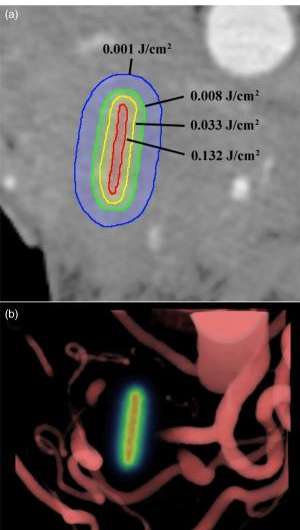An easier, safer, and more accurate treatment for pancreatic cancer

Using CT scans with contrast enhancement, Dartmouth researchers measured treatment response to pancreatic cancer photodynamic therapy (PDT) according to a paper published in Physics in Medicine and Biology.
The research team at Dartmouth set out to reduce the imaging obstacles for PDT, a minimally invasive and nontoxic treatment for cancer. "This study implies that treatment response can be reliably predicted using contrast CT. This would represent a major breakthrough in PDT for pancreas cancer that allows for easier, faster treatment tailored to an individual," said Brian W. Pogue, PhD, a researcher at Norris Cotton Cancer Center and Professor at Dartmouth's Thayer School of Engineering and Geisel School of Medicine.
The treatment response was related to pre-treatment images. "Basically, the more contrast uptake seen, the less the treatment had an effect," said Pogue. "We interpret this to mean that cancers with a high amount of blood volume and flow are harder to treat with this therapy."
Photodynamic therapy is a minimally invasive and nontoxic method of treating cancer with a drug, which, when activated by light, kills cancer cells. Cancer cells are identified using a drug called a photosensitizer. Other cells release the photosensitizer, but cancer cells hang onto the drug. When exposed to light, the cells containing the drug die. Since the response is chemically, not heat, induced, there is no damage to connective tissue.
Contrast CT was done on every patient's pancreas cancer prior to PDT treatment. The CT scan showed where the tumor was prior to treatment. After PCT, the scan was used to see how much of the tumor had been eliminated by the treatment.
Currently PDT presents many challenges for cancer treatment professionals and it is not commonly used in routine care. It can be hard to see which cancer cells have been killed, especially in pancreatic cancer, because the pancreas is nested in complex tissue and close to many organs. That makes it hard for clinicians to know what dose to use.
"Photodynamic therapy is a very effective way to ablate malignant tissue, and can be done with relatively minimally invasive delivery of light through a small fiber optic," said Pogue. "So it can be a reasonably good way to de-bulk inoperable tumors, such as pancreas cancer, where there is concern about delivering local targeting while also providing some synergy with other approaches to chemotherapy."
The study revealed a connection to the amount of blood in a tumor and its response to the light activated treatment. The blood absorbs light, which is used in photodynamic therapy to activate the drug. The more blood that is present, the less light is left to cause treatment effect; therefore, higher blood volumes reduce the effectiveness of the PDT treatment.
This finding indicates that blood volume in a tumor may be a simple surrogate measure for treatment response, which could potentially make photodynamic therapy easier, safer, and more effective for pancreatic cancer.
"The goals of the trial were simply to ensure that photodynamic therapy could ablate regions of tumor where the fiber was implanted. In a follow up study, we plan to study the relative effectiveness of killing the pancreas cancer specifically more than the normal surrounding pancreas," said Pogue.

















